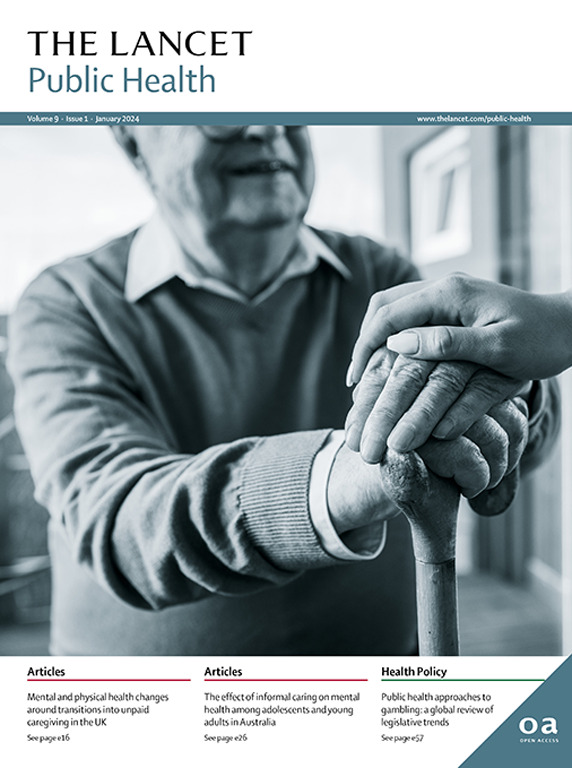我们的未来电子烟电子健康干预措施防止澳大利亚青少年学生使用电子烟:一项随机对照试验
IF 25.2
1区 医学
Q1 PUBLIC, ENVIRONMENTAL & OCCUPATIONAL HEALTH
引用次数: 0
摘要
青少年使用电子烟是一个全球性的公共卫生问题。可扩展的预防方法的效力尚未确定。我们的目的是评估以学校为基础的电子健康干预(我们的未来电子烟)在防止青少年使用电子烟方面的有效性。方法对澳大利亚新南威尔士州、西澳大利亚州和昆士兰州40所中学的7年级和8年级学生(12-14岁)进行了两组随机对照试验。生物统计学家使用R中的Blockrand函数,按州和学校性别构成分层,将学校随机(1:1)分配到OurFutures Vaping(一个四课的网络技能和教育项目)或积极对照组(通常的健康教育)。所有7年级和8年级的学生在参与的学校,英语流利,并提供同意有资格参加。教师、学生和研究人员没有被掩盖。主要结果是过去12个月的电子烟使用情况,在12个月的随访中进行评估。意向治疗分析使用广义混合效应回归进行,随机效应考虑了聚集在学校内的参与者。该试验已在澳大利亚和新西兰临床试验注册中心(ACTRN12623000022662)前瞻性注册。在2023年1月至10月期间,我们招募了49所学校(7653名学生)。9所学校在基线前退出(3所作为对照;6干预)。共有40所学校,符合条件的学生5157人,其中女生2329人(46.0%),男生2600人(51.3%);在干预组(20所学校,2449名学生)和对照组(20所学校,2708名学生)中,平均年龄13.30岁[SD 0.60]完成基线调查。与对照组相比,接受干预的参与者在接受干预一年后,过去12个月使用电子烟的几率降低(优势比为0.35 [95% CI 0.18 - 0.66], p= 0.0013),表明接受干预的学生与对照组相比,使用电子烟的几率降低了65%。无不良事件报告。“我们的未来”电子烟项目提供了一种有效的减少需求的方法,以防止青少年使用电子烟。资助医学研究未来基金和澳大利亚国家卫生和医学研究委员会。本文章由计算机程序翻译,如有差异,请以英文原文为准。
The OurFutures Vaping eHealth intervention to prevent e-cigarette use among adolescent students in Australia: a cluster randomised controlled trial
Background
E-cigarette use among adolescents is a global public health concern. The efficacy of scalable prevention approaches is yet to be established. We aimed to evaluate the efficacy of a school-based eHealth intervention (OurFutures Vaping) to prevent e-cigarette use among adolescents.Methods
A two-arm cluster randomised controlled trial was conducted among year 7 and 8 students (12–14 years) in 40 secondary schools across three Australian states: New South Wales, Western Australia, and Queensland. Schools were randomly assigned (1:1) to OurFutures Vaping (a four-lesson, web-based skills and education programme) or an active control group (usual health education) by a biostatistician using the Blockrand function in R, stratified by state and school gender composition. All year 7 and 8 students who attended participating schools, were fluent in English, and provided consent were eligible to participate. Teachers, students, and researchers were not masked to allocation. The primary outcome was past 12-month e-cigarette use, assessed at the 12-month follow-up. Intention-to-treat analyses were conducted using generalised mixed effects regression, with random effects accounting for participants clustered within schools. The trial was prospectively registered with the Australian and New Zealand Clinical Trials Registry (ACTRN12623000022662).Findings
Between January and October, 2023, we recruited 49 schools (7653 students). Nine schools withdrew before baseline (three control; six intervention). A total of 40 schools with 5157 eligible students (2329 [46·0%] girls and 2600 [51·3%] boys; mean age 13·30 years [SD 0·60]) completed the baseline survey in the intervention (20 schools, 2449 students) and control (20 schools, 2708 students) groups. Compared with the control group, participants who received the intervention had reduced odds of past 12-month e-cigarette use (odds ratio 0·35 [95% CI 0·18–0·66], p=0·0013) 1 year after receiving the intervention, indicating a 65% reduction in the odds of use among students who received the intervention compared with the control. No adverse events were reported.Interpretation
The OurFutures Vaping programme offers an efficacious demand-reduction approach to prevent e-cigarette use among adolescents.Funding
The Medical Research Future Fund and the Australian National Health and Medical Research Council.求助全文
通过发布文献求助,成功后即可免费获取论文全文。
去求助
来源期刊

Lancet Public Health
Medicine-Public Health, Environmental and Occupational Health
CiteScore
55.60
自引率
0.80%
发文量
305
审稿时长
8 weeks
期刊介绍:
The Lancet Public Health is committed to tackling the most pressing issues across all aspects of public health. We have a strong commitment to using science to improve health equity and social justice. In line with the values and vision of The Lancet, we take a broad and inclusive approach to public health and are interested in interdisciplinary research.
We publish a range of content types that can advance public health policies and outcomes. These include Articles, Review, Comment, and Correspondence. Learn more about the types of papers we publish.
 求助内容:
求助内容: 应助结果提醒方式:
应助结果提醒方式:


